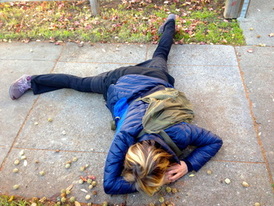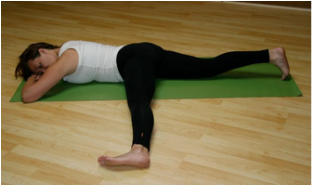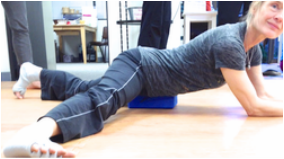Do you sometimes have stiffness behind the knee after you get up from sitting? Or maybe there's no pattern that you can figure out, yet, but you just get attacked at random moments by stiffness and discomfort in the back your knee, you feel kind of outraged because you are doing all kinds of things to figure out why you have imbalances and trying to unwind and understand them …
Okay, that is ME. It happens to me. I haven't figured out the key to why and when this happens, except that sometimes a flexed-knee position (like sitting in a chair, or even squatting) will set it up. I don't even know exactly "which muscle" is involved. I don't imagine it is just one muscle, and probably the reaction is set off by a pattern not even localized at the knee joint, but from a miscalculation in the hip and/or ankle and foot. I understand more every day (in fits and starts), but I do not have it all figured out.
Okay, that is ME. It happens to me. I haven't figured out the key to why and when this happens, except that sometimes a flexed-knee position (like sitting in a chair, or even squatting) will set it up. I don't even know exactly "which muscle" is involved. I don't imagine it is just one muscle, and probably the reaction is set off by a pattern not even localized at the knee joint, but from a miscalculation in the hip and/or ankle and foot. I understand more every day (in fits and starts), but I do not have it all figured out.
| However: I have found a trick that helps me! I'm calling it a trick, because one stretch by itself will not solve the whole-body problem, and isn't in itself a key answer that will unravel whole dysfunctional patterns, but - aren't tricks great when they have an immediate result! This is what's been working for me: one of Katy Bowman's 50 basic exercises from Restorative Exercise™, the "Prone Inner Thigh Stretch." I hope it's helpful for you, too. |
Here are instructions from Katy's blog: "Lie down with your belly flat on the floor. Reach one leg out to the side without bending the knees! Relax your head and neck on your hands. Try to bring your leg up until it is at 90°. . . If you have a hip replacement, only stretch the leg that has not been replaced."
(It's a great post about knee pain, osteoarthritis, and more: "Knee Bone Connected To The PF Bone".)
So simple: Lie prone ("on your stomach") on the floor with your pelvis flat on the floor and both legs straight, and reach one straight leg out to the side.
DETAILS AND MODIFICATIONS:
NOT quite so simple of course, because: 1) To not hurt your back, you need to keep your ribs from thrusting forward and your pelvis from anteriorly tilting. 2) Rushed into without caution, this position could set off a painful reaction for vulnerable hips or knees. 3) It's important to be working on not letting your knee turn down toward the floor, while you 4) work toward getting your pelvis flat on the floor (i.e. both ASIS's and pubic bone on the ground).
(It's a great post about knee pain, osteoarthritis, and more: "Knee Bone Connected To The PF Bone".)
So simple: Lie prone ("on your stomach") on the floor with your pelvis flat on the floor and both legs straight, and reach one straight leg out to the side.
DETAILS AND MODIFICATIONS:
NOT quite so simple of course, because: 1) To not hurt your back, you need to keep your ribs from thrusting forward and your pelvis from anteriorly tilting. 2) Rushed into without caution, this position could set off a painful reaction for vulnerable hips or knees. 3) It's important to be working on not letting your knee turn down toward the floor, while you 4) work toward getting your pelvis flat on the floor (i.e. both ASIS's and pubic bone on the ground).
- To take care of both issues in 1): Don't thrust your ribs! When you are prone, this will mean lifting your bottom ribs up away from the floor, not allowing your back to sag down and arch. Incidentally (NOT), keep your shoulders relaxed away from your ears, too.
- Try this for 2): Lying on your left side, lift your right leg up toward the ceiling and then lower it in front of you until your right foot is on the ground, then slide it forward until your body is prone. Voila you are in the position. Is it screamingly painful? STOP RIGHT NOW. Get out of it. (Roll back onto your side and bring your leg with you.) Try again and modify: Your leg does not have to go at a 90 degree angle, first of all, and your pelvis does not have to get horizontal to the floor yet. In general you need to modify so that it does not hurt . . .
|
~~~~~~~~~~~~~~~~~~~~~~~~~~~~~~~~~~~~~~~~~~~~~~~~~~~~~~~~~~~~~~~~~~~~~~~~~~~~~~
IMPORTANT: This doesn't make any difference in my knee stiffness unless I hold the position (RELAXING into it - not pushing!) for at least 1 minute.
~~~~~~~~~~~~~~~~~~~~~~~~~~~~~~~~~~~~~~~~~~~~~~~~~~~~~~~~~~~~~~~~~~~~~~~~~~~~~~
These cautions and modifications are of course for those of you who have trouble getting into this position, like me. I had to use a yoga block at first because I was so tight, but it got better!
IMPORTANT: This doesn't make any difference in my knee stiffness unless I hold the position (RELAXING into it - not pushing!) for at least 1 minute.
~~~~~~~~~~~~~~~~~~~~~~~~~~~~~~~~~~~~~~~~~~~~~~~~~~~~~~~~~~~~~~~~~~~~~~~~~~~~~~
These cautions and modifications are of course for those of you who have trouble getting into this position, like me. I had to use a yoga block at first because I was so tight, but it got better!
 AND IT WORKED.
AND IT WORKED. Now, when I go out for lunch with a friend and end up sitting in a chair for an hour and a half which I mostly avoid doing but I had a really nice time, and then I walk out onto the street and my knee has frozen up on the back side, maybe hamstrings mixed with adductors, maybe gastrocnemius, maybe popliteus who knows? I throw myself down on the sidewalk (this is Berkeley, it's allowed), and my friend shoots a photo of me, fixing myself. And it works. (For me. This time.)
If you have chronic pain and stiffness behind the knee it may have to do with a movement pattern of never really straightening your leg when you walk. See Katy Bowman's blog post: "Walking or Bouncing?"
If you have chronic pain and stiffness behind the knee it may have to do with a movement pattern of never really straightening your leg when you walk. See Katy Bowman's blog post: "Walking or Bouncing?"


 RSS Feed
RSS Feed